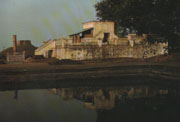
 Nirvana
Treks & Expedition Pvt. Ltd.
Nirvana
Treks & Expedition Pvt. Ltd.

| Lumbini is the birthplace
of Lord Buddha, known as the Light of Asia, the prince of peace, and the
Apostle of Non-Violence. Situated in southwestern Terai of Nepal, it is
250 kms from Kathmandu and 20 kms from Bhairawa. Pilgrimage to Lumbini
attains the same status to the Buddhist as the Mecca to the Muslims and
Jerusalem to the Christians. The sacred Garden in Lumbini, where Lord Buddha
was born more than 2500 years ago, has brought nations together, and it
is evident that the teachings of Lord Buddha on peace, tolerance and harmony
have come true, at least in Lumbini.
The monuments built in the International Monastic Zone by various countries with their distinct styles and designs contitute the symbol of universal harmony. The Ashokan Pillar, erected in 250 BC by the Indian emperor Ashoka as a testimony to his pilgrimage to Lumbini, has an inscription in Brahmi script. This is believed to be the oldest of its kind, and it declares Lumbini as the birthplace of Lord Buddha. Nearby the pillar is a sacred stone bearing the foot imprint supposed to be of Ashoka, which is assumed to pinpoint the edact birthplace of the Buddha. There is also the sacred pond, Puskarni, where Lord Buddha's mother Queen Maya Devi had taken bath before giving birth to Prince Siddartha Gautam who became the Buddha, the Enlightned One. Around the pillar and the pond are the remains of stupas, monasteries and palaces. Tilaurakot, the next archeological site, is located 27 kms to the west of Lumbini. It is where one can find the ruins of the palace of King Sudhodhan, the father of Lord Buddha. Tilaurakot's Kapilvastu Museum is the one where one can see earthen vessels, statues, coins, and ornaments of ancient times. Niglihawa, a few kilometers away to the northeast from Tilaurakot, is notable for monumental ruins and a broken Ashokan Pillar. Taulihaw, Sagarhawa, Gothihawa and Arorakot are the other appealing Buddhist sites, each having a vast conglomeration of antiques which are of significant importance from historical and archaeological points of view. The Lumbini International Research Institute, at the International Monastic Zone, has an archive of over 7,500 books. Many of the tomes are rare, and are written in Nepal Bhasha (Newari), Nepali, Hindi, Japanese, English, French, German, Italian, Sinhalese, Burmese, Thai and Pali This residential complex facilitates researchers and scholars, and helps academics and students in their research on Buddhism and other religions. Many rare books on ancient arts, cultures, religions, schools of Philosophy, and architecture have been preserved. |
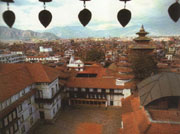
| Marvelous ancient temple,
palace courtyards and streets grace Kathmandu Durbar Square, or Hanuman
Dhoka Palace Complex. The Royal complex was the residence of royal complex
was the residence of royalty until the last century. Even to date, many
important ceremonies are held in one or the other courtyards within this
complex. The coronation of the Nepalese monarch also takes place here.
It is also called Basantpur Durbar because of a towering palace added to
the complex by King Prithvi Narayan Shah.
The Durbar is divided into two principal chowks (courtyards). The outer chwok consists of the Kasthamandap, Kumari Ghar, and Shiva-Parvati Temple, among other important landmarks. The inner chowk consists of the Hanuman Dhoka and the principal durbar. There are other chowks such as the Nasal Chowk, Sundari Chowk and Mohan Chowk. The Durbar complex also consists of four towers -Basantpur, Kirtipur, Lalitpur, and Bhaktapur. The palace complex is located in the heart of old Kathmandu City. It also houses two museums- one the open-air museum, and the other being King Tribhuvan Memorial Museum. Most premises of the Durbar are open for tourists, and can be visited throughout the week between office hours. Parts of the Durbar are used for national festivals, and are open only to the King and certain priests. |

| Pashupatinath temple, one
of the most sacred Hindu shrines in the world, is about five kilometers
northeast of Kathmandu. The two-storied pagoda style temple houses a sacred
lingam, the phallic symbol of Lord Shiva. Through the eastern Nepalese
Kiranti rulers established the temple before 4th century, it was given
the present shape only in the early 18th century. The temple, noted for
its gold-plated roofs and silver-coated doors, is open only for Hindus.
|
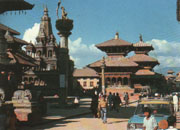
| The Patan Durbar Square is a cluster of marvelous monuments within a limited space. Besides the old royal Palace, which is ful of old royal palace, which is full of grace and grandeur, there is the 17th century Krishna Mandir, entirely made of stone in unique Shikhara-style structure with 21 pinnacles. The marvelous Tusha Hiti, Sundari Chowk, Taleju Temple, the Keshav Narayan Chowk are the other landmarks within the square. The Hiranya Varna Maha Vihar (Golden Temple), Rudra Varna Maha Vihar and the terra cotta Shikhara temple of Maha Bouddha are the consummate masterpieces in the vicinity. |
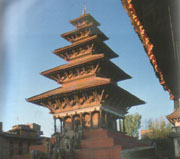
| The Bhaktapur Durbar Square is the best preserved of the Kathmandu Valley's three Durbar Squares. It is a conglomeration of pagoda and shikhara-style temples grouped around the splendid palatial complex known as 55-window palace, built of bricks and wood. The Golden Gate, Lun-Hiti (Golden Spout), the Taleju Temple complex and Nyatapole, the Five-Storied temple in the nearby Taumadi Square, are the other charming artistic masterpieces of Bhaktapur. Tfhe world famous peacock window at Tachapal, the 15th century Dattatreya Temple, and Nepal's largest Shiva Lingam (Phallus) at Hanumanghat are also enshrined in this artistic city. |
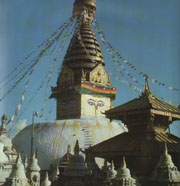 This is one of the world's
most glorious Buddhist Chaityas. It is said to be 2000 years old. Painted
on the four sides of the spire bases are the all-seeing eyes of Lord Buddha.
It is 3km west of Kathmandu city and is situated on a hillock about 77m.
above the level of the Kathmandu Valley.
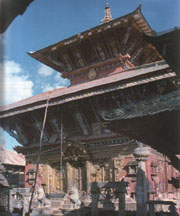 |